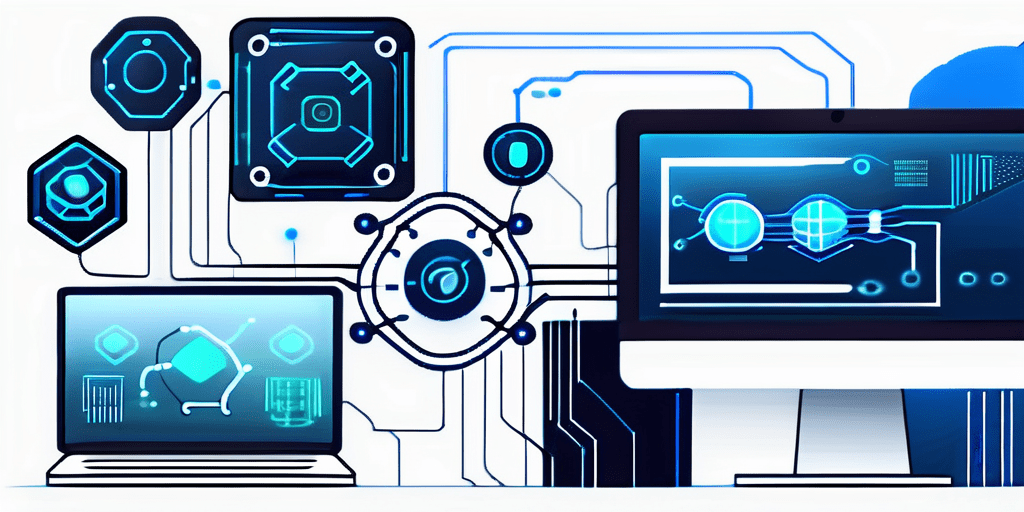Embedded operating systems play a crucial role in powering various devices and systems that we use on a daily basis. From smartphones and smart appliances to industrial machinery and automotive systems, these operating systems are the foundation that enables these devices to perform essential functions efficiently. In this article, we will delve into the world of embedded operating systems, understand their significance, explore popular options, compare their features, and discuss important considerations for choosing the right one for your specific requirements.
Understanding Embedded Operating Systems
An embedded operating system, also known as a real-time operating system (RTOS), is a specialized software that controls the operation of embedded devices. Unlike general-purpose operating systems like Windows or macOS, embedded operating systems are designed to be lightweight, responsive, and reliable. They are tailored to meet the unique requirements of embedded systems, which often have limited resources such as processing power, memory, and storage.
The importance of embedded operating systems cannot be overstated. They enable devices to perform specific functions, handle input and output tasks, manage system resources efficiently, and provide a reliable and responsive user experience. Using an embedded operating system, developers can focus on building applications and software that run on top of the system without worrying about low-level hardware interactions.
Definition and Importance of Embedded Operating Systems
Embedded operating systems are software systems specifically designed for embedded devices, which are typically specialized computer systems that perform dedicated functions. These systems are often resource-constrained and require an operating system that can efficiently manage those resources and provide real-time responsiveness.
The importance of embedded operating systems lies in their ability to enable the development of reliable and efficient devices. Embedded operating systems simplify the development process and allow developers to focus on creating innovative applications by providing a layer of abstraction between hardware and software components.
For example, in the automotive industry, embedded operating systems control various systems such as engine management, infotainment systems, and advanced driver-assistance systems (ADAS). These systems require real-time responsiveness and high reliability to ensure the safety and performance of the vehicle.
Key Features of Embedded Operating Systems
Embedded operating systems come with a range of features that make them suitable for use in embedded systems:
- Real-time responsiveness: Embedded operating systems are designed to provide real-time processing capabilities, allowing them to respond to events and inputs quickly and predictably.
- Resource management: These operating systems efficiently manage system resources such as CPU usage, memory allocation, and power consumption to ensure optimal performance.
- Small footprint: Embedded operating systems are lightweight and have a small memory footprint, making them ideal for devices with limited resources.
- Device driver support: They provide support for various hardware devices and peripherals, allowing developers to easily interface with sensors, displays, communication interfaces, and other external components.
- Security features: Embedded operating systems often include security mechanisms to protect the device and its data from unauthorized access and malicious attacks.
Real-time responsiveness is a crucial feature of embedded operating systems. It ensures that time-critical tasks are executed within strict deadlines, making them suitable for applications such as industrial automation, medical devices, and aerospace systems. These systems require precise timing and immediate response to external events, and embedded operating systems deliver on these requirements.
Resource management is another key feature of embedded operating systems. With limited resources available in embedded devices, efficient management becomes essential. These operating systems intelligently allocate resources, such as CPU usage and memory, to ensure optimal performance. By effectively managing resources, embedded operating systems enable devices to operate smoothly and reliably.
In addition to real-time responsiveness and resource management, the small footprint of embedded operating systems is a significant advantage. With limited processing power and memory, embedded devices need an operating system that takes up minimal space. Embedded operating systems are designed to be lightweight, allowing them to fit within the constraints of these devices without compromising performance.
Device driver support is also a critical feature of embedded operating systems. These operating systems provide a wide range of drivers that allow developers to interface with hardware devices and peripherals easily. Whether it’s a sensor, display, communication interface, or any other external component, embedded operating systems offer the necessary support to integrate these devices into the system seamlessly.
Finally, security features are an integral part of embedded operating systems. With the increasing connectivity of embedded devices, ensuring the security of these systems and their data is of utmost importance. Embedded operating systems incorporate various security mechanisms, such as encryption, authentication, and access control, to protect against unauthorized access and malicious attacks. By prioritizing security, these operating systems provide a robust foundation for building secure embedded devices.
Overview of Common Embedded Operating Systems
Several embedded operating systems are widely used in different industries. Let’s take a closer look at some of the popular options:

Linux for Embedded Systems
Linux is a versatile operating system that has gained significant popularity in the embedded systems space. It offers a wide range of features and supports various hardware architectures, making it suitable for diverse applications. Linux provides a rich development ecosystem with vast open-source software libraries and tools. Many companies, including Toyota and General Electric, have embraced Linux for their embedded systems.
Real-Time Operating Systems (RTOS)
A real-time operating system (RTOS) is designed to provide guaranteed response times for critical tasks. RTOSes prioritize time-sensitive operations, ensuring they are completed within specified timing constraints. Examples of RTOSes commonly used in embedded systems include FreeRTOS, ThreadX, and Zephyr. Companies like SpaceX rely on FreeRTOS to control critical operations in their space missions, demonstrating the importance of real-time responsiveness in embedded systems.
Windows Embedded Compact
Windows Embedded Compact (formerly known as Windows CE) is a variant of the Windows operating system specifically tailored for embedded systems. It offers a familiar development environment for Windows developers, making creating applications for embedded devices easier. Windows Embedded Compact provides many features and supports various hardware platforms. Companies like Honeywell and Nikon leverage Windows Embedded Compact for their embedded applications.
FreeRTOS
FreeRTOS is a popular open-source real-time operating system kernel highly regarded for its small memory footprint, portability, and ease of use. It has gained widespread adoption in various industries, including automotive, healthcare, and consumer electronics. Companies like Bosch and Philips use FreeRTOS in their products to ensure real-time performance.
In addition to these well-known embedded operating systems, several other options are available in the market. One such option is QNX, a real-time operating system developed by BlackBerry. QNX is known for its reliability and security features, making it a preferred choice for automotive and medical devices industries.
Another notable embedded operating system is VxWorks, which Wind River Systems developed. VxWorks is widely used in industries that require high-performance and real-time capabilities, such as aerospace and defense. It offers a comprehensive set of tools and libraries for developing embedded applications.
When choosing an embedded operating system, it is essential to consider factors such as the application’s specific requirements, hardware compatibility, and development ecosystem. Each operating system has its strengths and weaknesses, and the selection should be based on the unique needs of the project.
Comparing Embedded Operating Systems
When choosing an embedded operating system for your project, there are several factors to consider. Let’s explore some key aspects to compare:

Performance and Efficiency
The performance and efficiency of an embedded operating system play a crucial role in determining the overall system performance. Factors such as system responsiveness, power consumption, and resource usage impact the user experience and the device’s battery life. Evaluating benchmarks and real-world performance metrics can help in making informed decisions.
For example, a study conducted by the University of California, Irvine, demonstrated that devices running Linux-based embedded operating systems exhibited better performance and lower power consumption compared to those running Windows Embedded Compact.
Furthermore, performance and efficiency can also be influenced by the choice of hardware components. For instance, using a high-performance processor and optimized memory modules can significantly enhance the overall system speed and responsiveness.
Scalability and Flexibility
Scalability and flexibility are essential considerations, especially if your project requires the ability to adapt to changing requirements or support a wide range of hardware platforms. Some operating systems offer comprehensive support for different hardware architectures, making it easier to port applications across various devices.
For instance, Real-Time Systems GmbH provides their PikeOS operating system, which offers a scalable and flexible platform that supports both safety-critical and non-safety critical applications. This allows developers to use a single operating system for a wide range of system requirements.
In addition to hardware compatibility, the scalability of an operating system can also refer to its ability to handle increasing workloads or accommodate additional features without compromising performance. This can be achieved through efficient resource management and modular design principles.
Security Features
Security is paramount in embedded systems, especially in applications handling sensitive data or connecting to the internet. Embedded operating systems with robust security features can help prevent unauthorized access, protect against cyber threats, and ensure data integrity and confidentiality.
Green Hills Software’s INTEGRITY-178TU operating system, used by companies like Boeing and Raytheon, is certified to the highest levels of security for handling critical systems. It provides a secure and trusted foundation for embedded applications in industries such as aerospace and defense.
Moreover, security features can include encryption algorithms, secure boot mechanisms, and access control policies. Regular security updates and patches are crucial to address emerging vulnerabilities and protect against evolving threats.
Choosing the Right Embedded Operating System
Choosing the right embedded operating system for your project requires careful consideration of your system’s specific requirements. Here are some important factors to keep in mind:
Assessing Your System Requirements
Analyze the specific needs of your embedded system, such as real-time processing, memory footprint, power consumption, and hardware compatibility. Understanding these requirements will help narrow down the options and identify operating systems that best align with your project goals.
Real-time operating systems, like FreeRTOS or an RTOS vendor solution, are designed to handle time-sensitive applications that require precise timing and quick response to external events. These operating systems prioritize tasks based on their urgency, ensuring that critical operations are executed without delay.
On the other hand, if your embedded system requires a small memory footprint and low power consumption, you may consider lightweight operating systems like Contiki or TinyOS. These operating systems are designed to run efficiently on resource-constrained devices, making them ideal for applications with limited hardware capabilities.
Understanding Vendor Support
The level and quality of vendor support can make a significant difference in the success of your project. Evaluate the vendor’s reputation, track record, and community engagement. A vendor with excellent support can provide timely updates, bug fixes, documentation, and assistance when facing challenges during development.
Companies like NXP Semiconductors offer comprehensive support for their embedded operating systems, such as QNX Software Systems, ensuring that developers receive the necessary assistance and resources when using their platforms. This support includes access to a dedicated team of experts who can help troubleshoot issues, provide guidance on best practices, and offer training programs to enhance developers’ skills.
Additionally, vendors that actively engage with the developer community foster collaboration and knowledge sharing. They may host forums, webinars, and conferences where developers can connect with peers, exchange ideas, and gain insights into the latest trends and advancements in embedded systems development.
Cost Considerations
Cost is an important factor to consider, particularly if you are working within a budget. Evaluate the licensing models and the associated costs of the embedded operating systems you are considering. Some operating systems are open source and free, while others require licensing fees.
For instance, Wind River offers VxWorks®, which is a widely-used real-time operating system that comes with a range of licensing options to suit different budgets and project requirements. The availability of both community and commercial editions provides flexibility for developers. The community edition allows developers to explore and experiment with the operating system at no cost, while the commercial editions offer additional features, support, and services for those who require a more robust solution.
It’s important to weigh the benefits and costs of each operating system, taking into account the long-term implications for your project. Consider factors such as scalability, future maintenance and updates, and the potential for additional licensing fees as your project evolves.
Future Trends in Embedded Operating Systems
The landscape of embedded operating systems is constantly evolving to meet the demands of emerging technologies. Here are a couple of future trends worth keeping an eye on:

Impact of IoT on Embedded Systems
The Internet of Things (IoT) is revolutionizing the embedded systems industry by connecting devices, sensors, and actuators to the internet, enabling seamless communication and data exchange. This trend necessitates the development of embedded operating systems that support IoT connectivity protocols and provide robust security mechanisms to protect against IoT-specific threats.
With the rapid growth of IoT, the number of connected devices is expected to reach billions in the coming years. This surge in connectivity presents both opportunities and challenges for embedded operating systems. Manufacturers are focusing on creating lightweight and efficient operating systems that can handle the massive influx of data generated by IoT devices. Additionally, the need for secure communication and data privacy has led to the development of advanced encryption algorithms and authentication protocols.
Companies like ARM and MediaTek are actively involved in building operating systems and platforms tailored for IoT devices, enabling efficient and secure IoT deployments. These platforms offer developers a range of tools and libraries to simplify the development process and accelerate time to market.
The Role of AI in Future Embedded Systems
Artificial Intelligence (AI) is rapidly transforming various industries, and embedded systems are no exception. The integration of AI capabilities into embedded operating systems enables intelligent decision-making, machine learning, computer vision, and natural language processing at the edge.
AI-powered embedded systems can potentially revolutionize healthcare, automotive, and manufacturing industries. For example, AI algorithms running on embedded systems in healthcare can analyze patient data in real-time, enabling early detection of diseases and personalized treatment plans. In the automotive industry, AI-powered embedded systems can enhance autonomous driving capabilities, improving safety and efficiency on the roads.
Companies like NVIDIA with their Jetson platform and Google with TensorFlow Lite for Microcontrollers are driving the adoption of AI in embedded systems, offering hardware-accelerated AI capabilities coupled with optimized operating systems. These platforms provide developers with the tools and frameworks necessary to harness the power of AI in their embedded applications.
As technology continues to evolve, exploring common embedded operating systems is essential to navigate the complex landscape of choices available for developers. Understanding the key features, comparing different options based on performance, scalability, flexibility, and security, and considering system requirements, vendor support, and cost considerations are crucial steps in choosing the right embedded operating system for your project.
By staying informed about the latest trends and advancements in the field, developers can make informed decisions and stay ahead in this dynamic industry. The impact of IoT and the role of AI are just two examples of the exciting possibilities that lie ahead for embedded operating systems.
As you navigate the complexities of embedded operating systems and integrate cutting-edge AI capabilities into your devices, the importance of robust cybersecurity cannot be overstated. Blue Goat Cyber, a Veteran-Owned business, specializes in B2B cybersecurity services tailored to your needs, including medical device cybersecurity, penetration testing, and compliance with HIPAA, FDA, SOC 2, and PCI standards. Ensure your embedded systems are fortified against threats, and your business is protected. Contact us today for cybersecurity help and partner with a team passionate about securing your technology.
